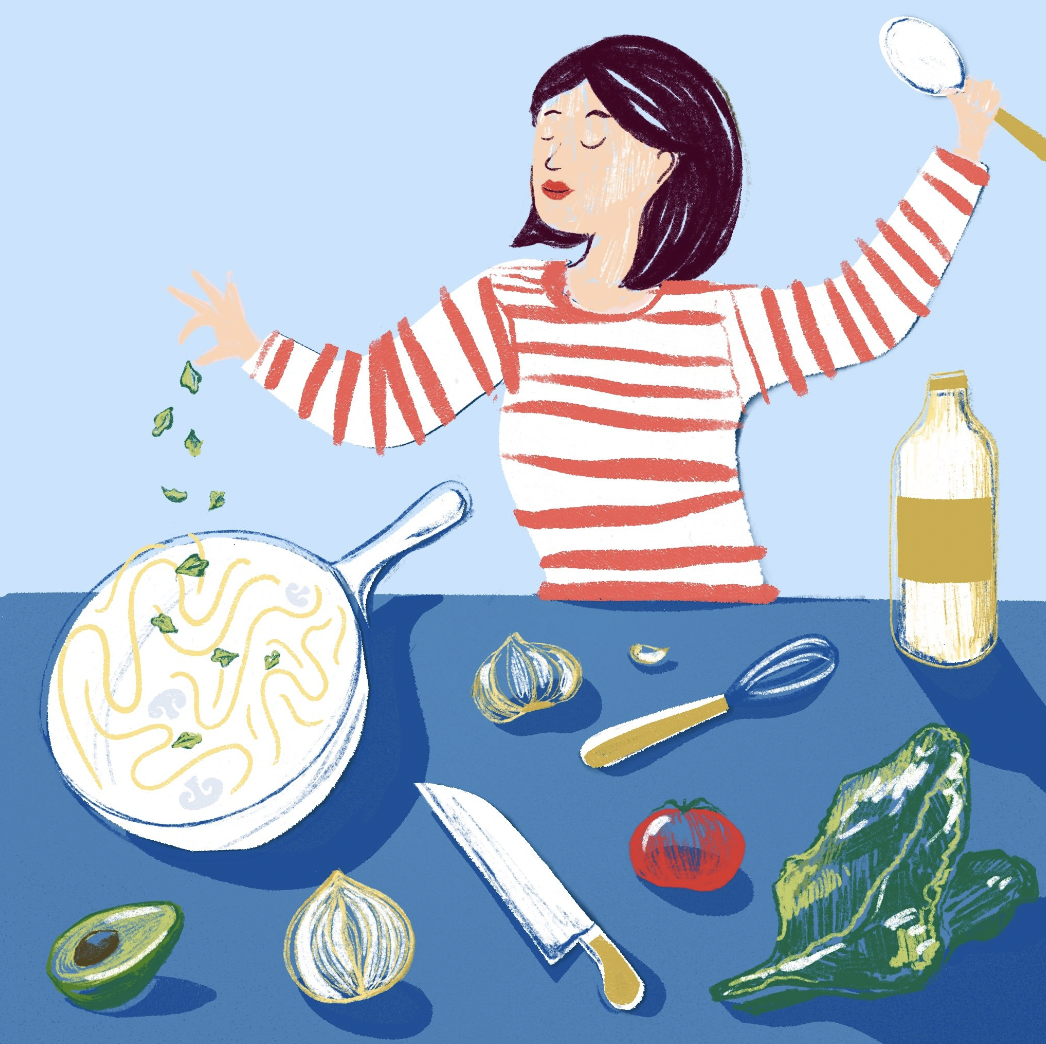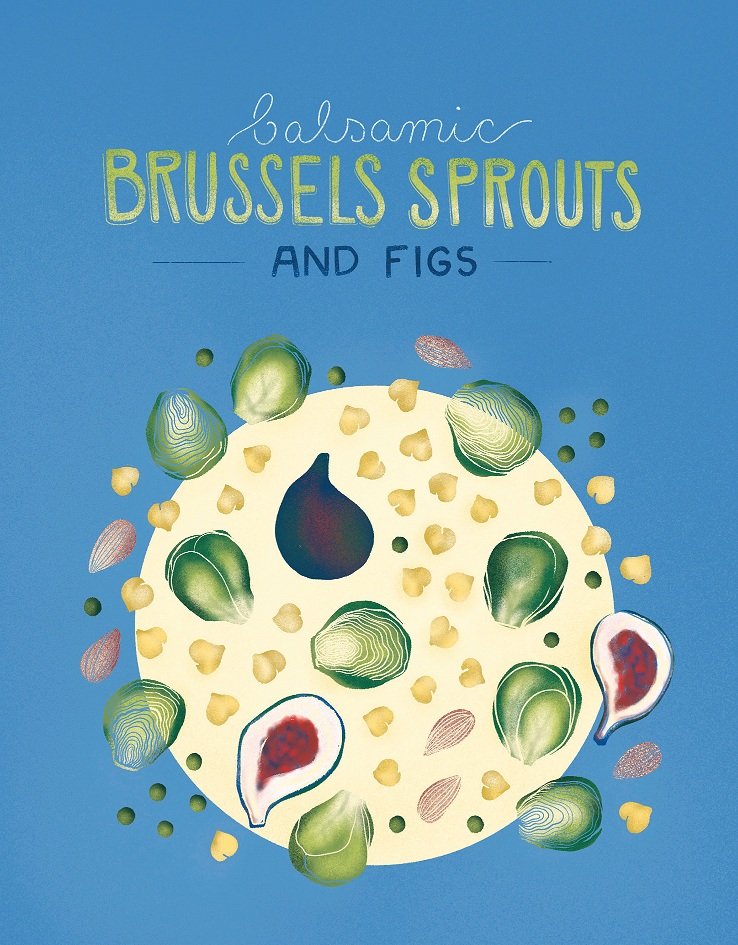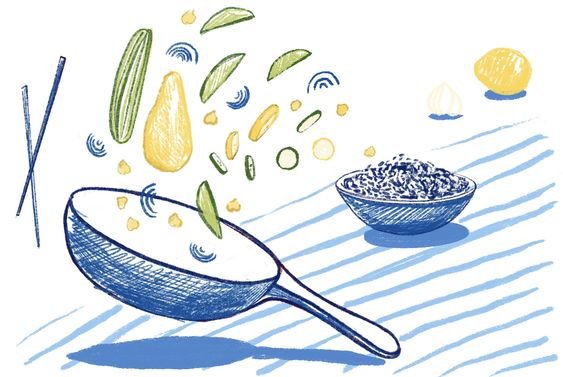Betsy Freeman Wants To Streamline Dinner
Betsy’s recipes aim to bring flexibility and creativity to your weeknight cooking. Illustration: Betsy Freeman
Betsy Freeman is on a mission to streamline your dinner plans. She literally wrote the book on it. Crafted to minimize wasted food and time spent cleaning up, her The One & Done Cookbook is your guide to escaping your weeknight dinner funk.
Betsy perfected the dishes using the principles she relies on in her day job as a product designer. She trimmed the instructions and number of cooking tools to what was most essential. She learned what recipes did and did not work and iterated from there. Design. Test. Refine. Repeat. Her recipes are crafted to gradually improve a reader’s cooking intuition.
With each recipe showcasing the versatility of simple plant-based ingredients, Betsy coaxes readers of all skill-levels to get creative in the kitchen.
The One & Done Cookbook features a chapter with 48 plant-forward one-pot dinner ideas. Image source: Betsy Freeman
product design principles make cooking easier
SPP: I know that experimenting and testing are important stages in perfecting software design. What was the testing process like when crafting your cookbook recipes?
BF: One of the core principles of product design is that it’s built around the customer, meaning everything we do is tested by the customer at every stage. So I let my customer—in the beginning my family and my friends—give me honest feedback at every stage of recipe testing.
For the cookbook, we had a ton of recipe testers. They not only tested the recipe results, they evaluated the cooking process. I definitely learned a lot from them, and tightened up my own skills in the process.
Something to note when you bring your customer into your recipe development: Not only do they give you feedback, they really pull on your empathy strings. When engaging those other testers, I just wanted the food to be the best it could be. And that urge exceeded anything I could have manufactured just by cooking by myself. I wanted them to have a good dinner.
The recipes in The One & Done Cookbook are primarily plant-based and low-waste. What motivates you to prioritize sustainability in the kitchen? How does your sustainable approach to food relate to your solution-oriented product design background?
I have a real passion for taking things that are overly complicated and then helping people get from point a to point b more easily. For me, that can often mean helping people with a fridge full of food avoid wasting it.
A lot of my passion for minimizing food waste is just how I was raised. I grew up in Colorado with an understanding of nature and how much effort goes into every bit of food, including how many miles that ingredient has traveled to be where it is on the table. So seeing food wasted kind of just kills me.
I totally agree that washing dishes is the worst part of making dinner. And I also know that your product design background helped you craft your time-saving one pot recipes. What factors do you have to keep in mind when formulating one pot dishes, as opposed to more labor-intensive recipes?
“If you don’t have time to be creative, just cook dinner.”
It’s a good question! There are principles involved in design proposals that might feel restrictive initially, but can end up making the process a lot easier. So a principle like “use as few dishes as possible” actually helps me be more creative. Also, let’s understand that by limiting a dish to one pot you aren’t necessarily limiting flavor. Many times, focusing on the one pot actually helps enhance flavors.
Thinking about cooking as a sustainable life practice, it’s important that you don’t just have this Mount Dishmore at the end of making dinner. By taking away some of that friction, you’re actually enabling yourself to cook more often.
I keep bumping into this cool insight that cooking is a necessity but you can use that to tap into your own creativity. For a lot of people, if you don’t have time to be creative, just cook dinner, and then you’re having some sort of creative practice.
Betsy often illustrates the staple plant-based foods, like legumes, that ground her affordable recipes. Image source: Betsy Freeman
Plant-Based Cooking Hacks
I love eating plant-based foods. However, I sometimes peek into my fridge, feel overwhelmed by the random ingredients, and order takeout. What’s the first step I should take when selecting the building blocks of a plant-based meal?
When you’re cooking plant-based, it seems like it requires a different way of framing a meal than cooking with meat. Typically meat is the star player on a plate. You think of dinner as a chicken with a side of fill-in-the-blank.
What I try to tell people is to keep that same framing of a star player, and then work around it. Look into your fridge or your farmers market, and find something in season that draws your attention—like maybe some really beautiful, delicious-looking tomatoes. Once you select your star think what carb or fat could go with it. For tomatoes, a carb can be a grain or thick toast. From there, the accompanying ingredients just build up.
Food prices right now are no joke. (Especially here in San Francisco!) What are your tips for plant-forward grocery shopping without breaking the bank?
In addition to dozens of one-pot recipes, The One & Done Cookbook features chapters on sauces and recipe-free cooking hacks. Image source: Betsy Freeman
I was raised mostly vegetarian, and part of the reason I was reluctant to start eating meat is because, wow, meat is so expensive. You can really save a lot of money eating plant-based. But—asterix here—buying a lot of specialty labeled vegan and vegetarian things can get you into trouble fast, so keep it basic!
My tip for folks is to consider alternatives when trying out recipes. I offer as many substitutes as I can in my cookbook to help readers avoid pricier ingredients they might not have. For example, a lot of plant-based recipes will call for pine nuts, hazelnuts, and cashews. By using raw sunflower seeds you can turn a $20 recipe into a $10 recipe.
The more you cook plant-based, the less you will feel beholden to buying all the “right” groceries.
If there’s one thing I know about you, it’s that you’re all about the sauces! The One & Done Cookbook really emphasizes the importance of jazzing up plant-based foods with the right sauce. What’s your go-to sauce that everyone needs to keep on hand?
What I’m always telling people is, “The secret sauce of life is just really good sauce.” I think my go-to is tahini, lemon juice, and then I use coconut aminos, which is similar to soy sauce or a thin teriyaki sauce. But you could always use just a dash of maple syrup and soy sauce. I also loving working with cooling yogurt-y sauces and offer a few variations on those in my book.
Cooking And Self-Care Practices
You’ve written about getting screen-fried from working on a computer all day. I can definitely relate. What role does cooking play in your selfcare and work life balance?
Working on screens is artificial in the sense that things move really fast. You have 10 people talking to you at once and you’re always multitasking. That’s not really how the physical world works.
“Sometimes I find myself getting frustrated, looking for cooking shortcuts and wanting to “command z,” but usually cooking helps me to unwind.”
When you’re cooking it slows things down. It’s very manual and methodical. When you’re chopping an onion, for instance, you have to watch your hands so you don’t cut yourself. It helps me get in touch with the rhythm of things. Sometimes I find myself getting frustrated, looking for cooking shortcuts and wanting to “command z,” but usually cooking helps me to unwind.
My partner and I cook together most nights, and it’s really great. He also works on a screen, so we can talk, or, if we’re really fried out, we don’t even have to talk. We just chop next to each other, listening to music. I definitely would recommend it to folks looking to work on their work life balance.
A really special part of The One & Done Cookbook are your vibrant illustrations. Tell me about your artistic process and how it helps you understand food?
Betsy’s newsletters include whimsical art pieces walking readers through her recipe development. Illustration: Betsy Freeman
What inspired the cookbook is that illustrating food and making food are very interconnected in my mind. When I’m cooking, I’m thinking about what’s beautiful. If something looks good, it usually tastes good, and is fun to draw.
Drawing is also how I process my world and how I learn. As I experiment with different techniques in the kitchen, it’s my way of committing them to memory. When you spend 30 minutes drawing a pepper next to a zucchini you start remembering they go together!
This interview has been lightly edited for length and clarity. To learn more of Betsy’s advice on easy, plant-based, low-waste cooking, check out The One & Done Cookbook and subscribe to her newsletter.
Kate Green is a Stone Pier Press News Fellow based in San Francisco, CA.













